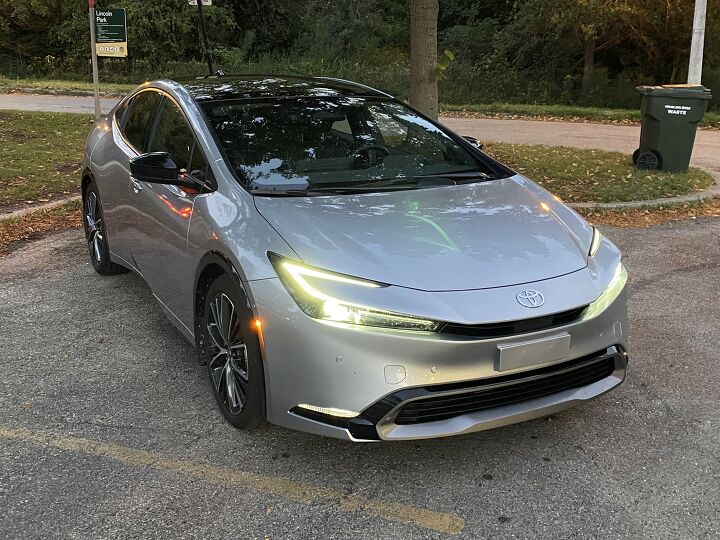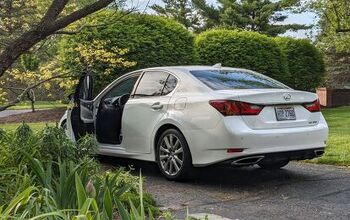2023 Toyota Prius Limited Review – Finally a Worthy Choice

2023 Toyota Prius Limited Fast Facts
The Toyota Prius was once reviled by most enthusiasts and often the butt of jokes, even in pop culture. Prius drivers were stereotyped as left-lane camping, NPR-listening, Green Party-voting smug virtue-signalers.
That stereotype was often unfair and inaccurate. But it was based in one truth – the Prius might save you a lot of gas but man it was no fun to drive. Nor did it offer much in the way of creature comfort. It was all about passing up gas pumps.
The 2023 Toyota Prius changes the narrative without sacrificing the core mission. Something I didn’t think could be done.
I’ve driven many a Prius over the years, and the 2023 version is the first one I’d even think about owning for any reason other than fuel mileage.
I never thought I’d see the Chicago Cubs win the World Series. I never thought I’d see the New Orleans Saints win the Super Bowl and I never thought Las Vegas would get a hockey team, let alone one that won a Stanley Cup just six seasons in. I also thought I’d never see a Prius that could be even a little bit fun to drive.
Well, I have lived long enough to see all of these things.
To be sure, the Prius is no sports car. But you can actually attack an on ramp with some confidence now. A road trip to Detroit and back wasn’t too punishing. And yes, the fuel mileage was still excellent.
The Prius is still not a burner, but the increased power provided by the 2.0-liter four-cylinder/electric motor pairing – 194 horsepower now for front-wheel drive models like my test car, and 139 lb-ft of torque for all models – erases the pokiness of the past and brings the car up to date. You still won’t win a lot if you drag-race this car, but you will be able to much more easily keep up with the flow of traffic.
Similarly, you won’t buy this car for its cornering ability, but it no longer feels like any level of aggression will overcome the tires and send you into the bushes. The ride is a bit stiff, but mostly acceptable, even for longer stints behind the wheel.
The exterior styling is more appealing now, rounding off the wedge shape into something that’s easier on the eyes.
Inside, the gauge cluster sits well ahead of the steering wheel, meaning said steering wheel sometimes obscures your view of the instruments. The large infotainment screen is sort of plopped on, and there are too many buttons and not enough knobs. The shifter is a bit wonky. It’s not as cohesive as the outside, and it’s not as user-friendly as I’d like, but the cabin is still somehow a step up from before. Once again, Toyota’s new infotainment system shines.
My biggest gripe was an intrusion of outside noise above 60 mph. The cacophony is livable for a while, but after driving across Michigan I felt like I’d just left a concert. I get it – sound deadening equals fuel-economy killing weight. And there are worse offenders out there. Still, if you want Lexus quiet from your hybrids, you’ll need to, you know, buy a Lexus.
Then again, a Lexus will cost a lot more. This Prius wasn’t a bargain at $38K, but that’s still under the average transaction price these days and within reach for plenty of folks.
The starting price tag here was a tick under $35K, and standard features included 19-inch wheels, LED headlights and DRLs, rain-sensing wipers, wireless Apple CarPlay and Android Auto, satellite radio, power liftgate, a fixed glass roof, keyless entry and starting, digital key, heated and cooled front seats, heated steering wheel, and wireless cell phone charging.
Toyota’s SafetySense 3.0 suite of driver’s aids was standard and included pre-collision assist, blind-spot monitoring, rear cross-traffic alert, and safe exit assist.
Options included a digital rearview mirror, panoramic view monitor, heated rear seats, and a dash cam.
Out the door price? $38,019.
Fuel economy is listed at 52 mpg across the board for city/highway/combined. According to the computer, I got about 44.9 mpg -- and the computer wasn't reset when I picked up the car. Some possibly suspect back of envelope math based on my notes showed about 48 mpg. Either way, good numbers though real-world fuel economy often falls short of the EPA rating, as it did here.
The Prius is still no sports sedan or sexy luxury ride. But it’s also no longer a penalty box that sacrifices performance and comfort at the altar of fuel economy.
Instead, it’s now a “have your cake and eat it too” situation. You get a commuter car that sips fuel while still having some popular convenience features and the ability to have a mild bit of fun.
That finally makes the Prius a worthy choice for those who are looking for more than just a cheap fuel bill.
Things change, sometimes for the better. Maybe the Detroit Lions are next in line for a championship.
[Images © 2024 Tim Healey/TTAC.com]
Become a TTAC insider. Get the latest news, features, TTAC takes, and everything else that gets to the truth about cars first by subscribing to our newsletter.

Tim Healey grew up around the auto-parts business and has always had a love for cars — his parents joke his first word was “‘Vette”. Despite this, he wanted to pursue a career in sports writing but he ended up falling semi-accidentally into the automotive-journalism industry, first at Consumer Guide Automotive and later at Web2Carz.com. He also worked as an industry analyst at Mintel Group and freelanced for About.com, CarFax, Vehix.com, High Gear Media, Torque News, FutureCar.com, Cars.com, among others, and of course Vertical Scope sites such as AutoGuide.com, Off-Road.com, and HybridCars.com. He’s an urbanite and as such, doesn’t need a daily driver, but if he had one, it would be compact, sporty, and have a manual transmission.
More by Tim Healey
Latest Car Reviews
Read moreLatest Product Reviews
Read moreRecent Comments
- Fred No idea why someone would interested in buying this at the price point. I'm pro-ev but a quick search can pull-up a lot more value at lower costs. I like the Fiat design but I couldn't stomach paying $37k for limited range and a super tight back seat.
- 28-Cars-Later For the you-gotta-be-rich-to-afford-a-cheap-car crowd, Versa is the winner here IMO. Buy it new and pay the $300ish (?) note, but enjoy at least five years with relative reliability assuming historical average miles. Based on MY19, Manheim expects the "S" to be worth $5,975 in roughly five years with "retail" value being $12,650. Nissan and other second or third tier marques will give more on a new trade so assuming 20 OTD with incentives its a 12K/$2,400 depreciation over 5 years excluding interest and it probably could be kept another year or two before the Nissan in it starts to show. Mirage in this comparison is the new buy used on the cheap and run it till the wheels fall off. I'm loathe to compare it to either the Panther or 240 (since I don't believe it could physically last as long as either) but something in the vein of car you could repair yourself on the cheap which was originally intended for Third World conditions. Based on MY19, the ES hatch is worth $4K even with avg miles of 72,740 and "retail" value at $9,650. I personally see it as lot poison and could see savvy buyers making off with one of these near or below wholesale while Nissan is a staple of the subprime crowd and is much easier to finance. MC beings up an interesting contender in the used Chevy Bolt, whose wholesale is $12,050 for MY19 in LT trim with avg lower miles of 33,017. While this is very intriguing, financing is going to be the story here since Nissan or I imagine Mitsubishi could put buyers into half decent rates despite poor credit where a Bolt is "going to the street" and getting whatever high rate is being offered now. Assuming one can handle their own charging, Bolt does offer a lower maintenance cost and used I believe buyers have a higher chance of a white collar professional's commuter condition than what they will find in a used Nissan or Mitsu runabout. The risk to our theoretical buyer IMO is that the Bolt will straight up fail at some point in the future, either not take a charge or even turn on and for the higher wholesale entry point I say the Mitsu is a better choice since it likely won't completely fail and can very cheaply be replaced. Additional: For your kid/nephew/niece/any "middle class" child, I think Bolt is probably the better proposition here but I'd be out of the trade in 36 mos personally. For those truly on their own with no emergency support system, I'd shy away.
- Jbltg It's interesting to note that in the Japan domestic market, where cars are built to order and dealers maintain barely any stock, that there are many, many color options. Really good ones, but no one seems to bite. Most of the cars on the road there are the same boring colors that we have. Go figure.My pet peeve is black interiors. Too depressing, and shows every speck of dust and dirt.
- IBx1 Dealerships flood the market with grayscale cars to commodify them and drive down resale value. Green and yellow cars hold their value best because they cannot easily be replaced, but you can throw a rock and hit fifty shades of gray.
- SCE to AUX Appliances (household and vehicular) have limited color choices, that's why.But today, if you want a crazy color, just buy a plain one and get it wrapped.







































Comments
Join the conversation
When GM was wasting development time on the excreable Bolt, Toyota was producing this masterpiece.
I had a '14 Prius from work - I hated driving it because the dynamics were just awful...but the mileage was amazing. Commuting home from NYC to the suburbs is what this car is made for. I would routinely get 60-62 MPG without making any effort to minimize gas use. If I used the driving aids designed to improve mileage (hey, spending 2 hours to drive 43 miles you look for things to pass time) I would get 72 MPG. Even the morning ride with minimal traffic saw 50 plus. Simply outstanding.